

How to calculate stretch percentage (with FREE print at home stretch percentage guide!) — megan nielsen design diary. In my sewing patterns created for stretch fabrics i often talk about the required fabric in terms of stretch percentage.
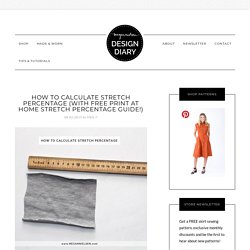
For example, in the Briar tee pattern i say that you need to use a fabric with at least 20% stretch. For my maternity patterns i generally suggest fabrics with at least 40% stretch. I feel like this is the best way of explaining exactly how stretchy your fabric should be to work with the design, but i know that if you’re not familiar with that measure it can be a little confusing. Thankfully it’s really really simple to calculate!
I’ll show you how to calculate it yourself, and at the end of this post you’ll be able to download our free print at home stretch percentage guide. Your stretch percentage is just the width of your fabric when stretched to it’s maximum divided by the width of your fabric when unstretched (minus 1). For example in the example shown below the stretch percentage would be 16/10-1 = 0.6 . Perfecting the Wrap Dress Serger Darts for Knits. Pamela Leggett Photo: Pamela Leggett Darts are notoriously difficult to sew in knits, especially if working with a very stretchy, thin knit.

Serging a dart is a bit unorthodox, but you will be astounded by how easy it is to do and how good the results are. In this tutorial, serger expert and instructor Pamela Leggett shares her method for achieving great-looking darts in knits by using a serger. This technique and others will be covered in greater depth in Pamela's upcoming serger online video brought to you exclusively by Threads and Craftsy. Seamwork Magazine. For the last decade, I have worked in the apparel industry in Portland, Oregon.

Because of the number of activewear companies here, both large and small, much of that work has been with athletic apparel. I’d like to share what I’ve learned about creating activewear that really lasts, and how some ready-to-wear techniques can be applied at home. When creating an athletic wear garment, it is important to make sure it will move with you. No matter what your activity—from a walk in the park, to yoga, to rock climbing, to Zumba—you want to create something that moves with your body. Nothing is worse than starting an hour-long dance class, only to discover that you are losing your leggings, or that you’ve popped stitches in a crucial seam. Many athletic garments have negative ease, meaning that the finished garment is smaller than your body and must be stretched when worn. {VFT Sewing Tips} How to attach a woven skirt to a knit bodice. Thursday, Oct 08 - posted by Ericka Today is our first “how to” article in a new planned teaching blog series!

This series will be an ongoing “how-to” where we share our library of tips and tricks (ones that we wish we had known when we started) that will change the way you sew! You know those “Ah-ha!” Moments where it all clicks and your project comes together easily and effortlessly? Most of the time those well deserved moments come from putting in the time and doing the research, right? Tutorial: Stabilizing and gathering knits with clear elastic (…and the book comes out in one week!) - Coletterie.
Tutorial: Sewing hems on knits with a twin needle - Coletterie. The cover-stitch and overlock - Shwin&Shwin. I love sewing with knits, which is nice because I love wearing knits, and my kids love wearing knits.

However I used to HATE sewing with knits and it was simply because I didn’t know how. Knits are different for sure, but they aren’t so bad and once you figure things out you will be whipping through knits like nobody’s business. So a while back I shared my Knits 101 post, and Ribbing 101, and today I am sharing all about the cover stitch and the overlock stitch. Both require special machines, but you don’t need special machines to sew with knits, they can just be helpful. The cover stitch is the double (or triple) stitch used for hemming knits or topstitching seams that need stretch. Sewing with knits. Remember Sewing 101?
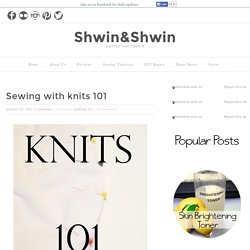
It was a fun little series we did last year, and well since then we have though a lot about adding to it. It won’t be like the series last year where it was nearly everyday for 5 weeks, but there will be some lessons here and there. Starting today with sewing with knits. It is the number one thing we get asked about. Knits make people nervous, or frustrated. 1. 2. 3. A stretch stich requires a fancy foot to do the stitch. 4. Then you thread your machine with two spools of thread. 5. Then when you hem, it is nice and smooth. 6. How to bind knit edges: the ultimate guide
Binding has a special place in my heart.
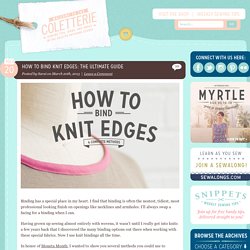
I find that binding is often the neatest, tidiest, most professional looking finish on openings like necklines and armholes. I’ll always swap a facing for a binding when I can. Having grown up sewing almost entirely with wovens, it wasn’t until I really got into knits a few years back that I discovered the many binding options out there when working with these special fabrics. Now I use knit bindings all the time. In honor of Moneta Month, I wanted to show you several methods you could use to substitute bound edges on your Moneta.
Straight out of the envelope, Moneta is finished with either a lining for the sleeveless version (we have a video to show you how), or a simple hemmed finish. Both of these are great finishes that work well with the design, but binding gives you a few more options. Bands vs. First, let’s clear up a little terminology. Briar Sewalong: Neckline Binding. And now on to my favourite knit neckline finish.
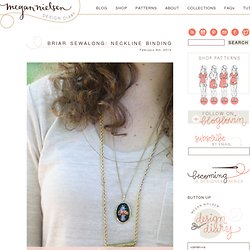
Binding! Now be warned – this is not your standard neckline binding, this is my method. I like it because it feels nice and sturdy/thick, all the raw edges are enclosed and there is no trimming off edges and things at the end – plus since the steps are similar to the collar band, some people find it less confusing. Sewing Knits Without a Serger As a sewing teacher, I have become acutely aware of a paradox that exists in the sewing community.
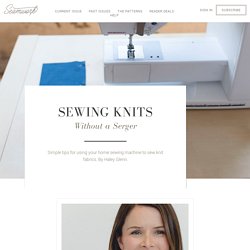
Though the average person’s wardrobe consists mostly of knitwear, the majority of seamstresses sew almost exclusively with woven fabric. This could be attributed to the misguided notion that sewing knits requires a serger. This is absolutely false! Though a serger makes the assembly of knit garments much faster, they are a costly addition to your sewing arsenal and are not imperative.